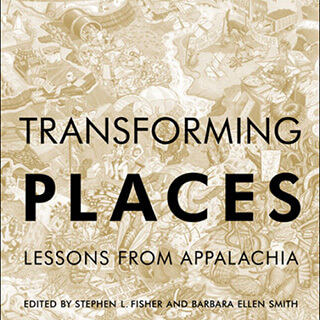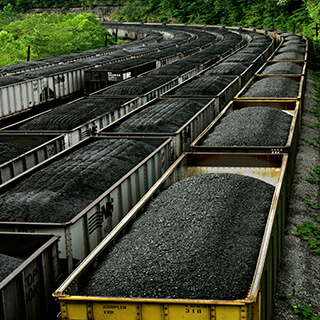Overview
Shirley Stewart Burns decries the ecological devastation produced by mountaintop removal in Appalachia.
"Mountaintop Removal in Central Appalachia" is part of the 2008 Southern Spaces series "Space, Place, and Appalachia," a collection of publications exploring Appalachian geographies through multimedia presentations.
In Search of Justice
Mother Jones once said, "There is no peace in West Virginia, because there is no justice [in West Virginia]." This is as true today as when she said it.
 |
| Map of the Central Appalachia region (Base Map Data: US Census Bureau) |
Despite living among the richest coal reserves and one of the most ecologically biodiverse regions in the world, the people in Central Appalachia, including those near my home in the southern West Virginia coalfields, are among the poorest people in the United States. Poverty rates here are at least twice that of the rest of the country. The people are mainly a rural, white population whose families have lived in Appalachia for generations, dating back to before the exploitation of the coal seams. People often ask, how could this happen? How could one of the most minerally rich places be populated by some of the poorest people? It happens because the economy here has revolved around the concentrated ownership of one resource—coal—for more than a hundred years.
 |
| Denny Tyler, Native plants manage to survive on the fringes of the Edwight Mountaintop Removal site, Raleigh County, West Virgina, 2008. |
In the Appalachian coalfields, the majority of land is owned by corporate interests based outside of the region. Connection to the outside markets came early for the coalfields' territory, and it was the region's initial connection to the world markets that led to the speculation of the area and to the vast number of absentee landowners. Natural resource identification, mapping, and purchasing occurred as early as the eighteenth century, but these absentee holdings could not be fully exploited until the late nineteenth and early twentieth centuries when the railroads entered the coal rich areas of Central Appalachia. With the natural resources owned by outside interests, the riches of the region flow outside the area with little wealth remaining in the areas most affected by the extraction.
Making this exploitation easier were the writings of local color writers and visiting journalists who for generations have written riveting stories of the beauty of Appalachia and how the inhabitants of the region are strange, different, and unlike the rest of the United States. This stereotyping has "othered" the people, made us "not as good as" and "different from" people in the rest of the country, and has justified the region's exploitation. Appalachia now finds itself in the precarious position where the defining features of the region, the mountains, face destruction for the coal within and underneath. There are few alternative economic opportunities in this persistently poor and distressed region.
To understand what the poor are up against in Appalachia, you must understand mountaintop removal (MTR), the latest and most extreme version of strip mining in which the tops of the mountains are blown away to gain easy access to the coal. This became a predominant form of mining in the mid-1990s, when the Clean Air Act emission standards were strengthened. While this may have been a good thing for the rest of the country, it was devastating for the coalfields of Central Appalachia. The new standards, enacted to protect the environment by reducing toxic air emissions, acid rain, and urban air pollution, had the unexpected, ironic effect of decimating thousands of acres of Central Appalachian forests and streams through MTR. Low-sulfur coal was needed to meet the more stringent emission requirements, and the Central Appalachian coalfields would find the extraction of its coal by MTR exacerbated as a direct response to this need.
 |
| Mark Schmerling, A mountaintop removal site looms over the community of Dorothy, Raleigh County, West Virgina, 2008. |
Tucked away in hollers throughout Central Appalachia, mountaintop removal has only recently received significant press coverage as the knowledge of global climate change becomes more pervasive and the scrutiny of coal's impacts becomes more mainstream. In the southern West Virginia coalfields where my study, Bringing Down the Mountains, is based, mountaintop removal is now a predominant method of strip mining. This allows coal companies quicker and cheaper access to millions of tons of coal while effectively eliminating the most expensive cost of doing business—labor. The average MTR mine employs eighty-nine people for an average of ten years. The average underground mine can employ upwards of three-hundred people for decades. So far, mountaintop removal has destroyed 450 mountains and, according to a federal environmental impact statement, by 2013 will have damaged or destroyed 2,400 miles of streams.
The people of the coalfields have joined together to form activist groups. Most had never been involved in such endeavors before mountaintop removal arrived and would not have identified themselves as environmentalists. They are essentially "accidental environmentalists." The history of the coalfields has always included everyday citizens who do extraordinary things, standing up against seemingly insurmountable odds. In the fight to save their communities, ordinary citizens have faced down non-responsive government officials, multinational conglomerate coal companies, and their own neighbors who make their living by mountaintop removal. In the area that is the focus of my study, numerous citizens have come forth to challenge the status quo. Among these are Mary Miller and Pauline Canterberry, in their late seventies, who headed up efforts to take dust samples from throughout their small town for a lawsuit against a coal company whose preparation plant rained coal dust over their community. Julia Bonds and Maria Gunnoe, natives of the southern West Virginia coalfields, have both won the Goldman Environmental Prize. They travel across the country speaking about the ecological and cultural crisis that Appalachia is currently facing. Larry Gibson has forged a decades-long struggle against the coal companies that surround his family's fifty acres of property that rests in the middle of an MTR mine.
 |
| Mark Schmerling, Larry Gibson and his dog, "Dog," overlook the destruction at Kayford Mountain, Kanawha County, West Virgina, 2006. |
These people, and hundreds like them, have taken a stand for the environment and their communities while those in power largely ignored their plight. But environmental justice in Appalachia is far from a reality. Lawsuits are frequently won in lower courts only to be overturned by the notoriously conservative Fourth Circuit Court of Appeals in Richmond, Virginia. Still, citizens keep pursuing lawsuits against coal companies that they believe are destroying their homes, their environment, and their culture.
The impacts of MTR on a community have become very personal for many. In my own hometown, a vast mountaintop removal site is separated from my family's cemetery by one ridge. It is the final resting place for nearly two hundred years of my ancestors, including my father. That particular MTR site spans five small communities, with effects on each. Citizens are divided on whether the impacts are good or bad, or both—because many of them make their living by MTR. In West Virginia, a 2002 study by the Flood Advisory Technical Task Force noted a correlation between flooding and MTR operations. Many of us have witnessed this firsthand. During the devastating floods of the Summer of 2001, I felt helpless as family members and close friends lost everything they owned. To the north of my home community rests the MTR site; to the south, timbering. My childhood home and my family never stood a chance. After these floods, all that was left was to pick up the pieces. Far from being "26 hard miles south of nowhere," as one Charleston Gazette newspaper opinion editorial called these communities, they are "somewhere" to thousands of us.
 |
| Vivian Stockman, The results of massive flooding, Wyoming County, West Virgina, 2004. |
It is easy for the rest of the country to flip on their light switches and never think where the energy is coming from. More than half of all US electricity comes from coal. It's the nation's dirty little secret. Even filthier is what is done to the land to get the coal. People talk passionately about clean coal technology, but this discussion revolves around whether it's possible to clean the burning of the coal. Overlooked in the "Clean Coal" dialogue is the extraction of coal through mountaintop removal. This process is inherently filthy, and it can never be clean! Along with the incessant dust and danger from blasting apart a mountain, the processing of this coal results in huge coal slurry impoundments that hold billions of gallons of toxic sludge, which contains concentrated toxic substances such as selenium, cadmium, boron, arsenic and nickel. In addition to the knowledge that these dams can break (as one did in Buffalo Creek, West Virginia, in 1972, killing 125 people and, more recently, in October 2000 in Martin County, Kentucky, polluting more than 75 miles of stream from Kentucky to West Virginia) is the fear that they are contaminating underground aquifers. The valley fills that are created with the refuse of the blasted apart mountains bury hundreds of miles of streams that feed the waters of the eastern United States.
While there is a long, tarnished history of Appalachian stereotypes being perpetuated by writers and the media, there is new opportunity for present day writers covering MTR to get it right. Come to Central Appalachia where mountaintop removal is rampant. Talk to the local people. Hear their stories and listen to their ideas for green energy, and sustainable jobs, in the middle of the coalfields. Read the updated histories that depict the people accurately. Take a look at what greed and wasteful consumption has done to one of the oldest mountain ranges in the world and to the people whose resources fueled the industrial revolution and enabled a modern standard of living. Write about us as if we were interconnected, as if what happens in the coalfields impacts you, and as if we mattered. Because it does, and we do.
The essay "In Search of Justice" grew from remarks delivered by Shirley Burns at the Society of Environmental Justice Conference, Roanoke, Virginia, October 18, 2008.
The Stages of Mountaintop Removal: An Excerpt from Bringing Down the Mountains
The most divisive and controversial environmental issue facing Central Appalachia today is mountaintop removal surface coal mining. Obtaining coal by mountaintop removal (MTR) obliterates Appalachian mountains and streams in several, methodical steps.
First, trees and vegetation are removed from the area to be mined, with the trees typically leased to a timber company to be logged and sold. The operator will sometimes save the removed topsoil or spread it over an existing stripped site. The area is prepared for pre-stripping using shovel loaders and dump trucks. During this phase, access roads are constructed to reach the preliminary operation. Next, the area is pre-stripped to make a foundation for a dragline, the piece of machinery that is most crucial to MTR. The dragline, a large earth-moving machine, can be as tall as twenty stories. It is this machinery that scrapes away the earth to get to the coal. This activity continues throughout the life of the MTR operation as area after area is prepared for stripping.
 |
| Mark Schmerling, Massive machinery is dwarfed by the size of this mountaintop removal site, Kayford Mountain, Kanawha County, West Virginia, 2006. |
The next is extraction. The exposed sub-soil and rock, known as overburden, is drilled, blasted, and removed from the area. Hundreds of feet may be removed from the top of the mountain during blasting. The now-exposed coal seam is splintered through blasting, and the coal is hauled away. The overburden is compacted and used to re-grade an already mined area. Any excess overburden remaining after the area is back-filled is placed into a valley fill, an area typically at the head of a hollow that is used for waste disposal. Then, reclamation (i.e., attempts to restore the area to a useful standard) occurs. This involves using the graded and compacted topsoil on the now-stripped site, and reseeding it for vegetation.1Shiva Kolli, "Analyses of Coal Extraction and Spoil Handling Techniques in Mountainous Areas" (master's thesis, West Virginia University, 2001), 26–28. MTR, a quick and efficient way to obtain coal, experienced an upsurge in popularity during the 1990s, though it had been used in earlier decades as well.
MTR came into widespread use to meet the demand created by the 1970s energy crisis. With the subsequent decline in coal demand during the 1980s, the method gained in popularity with the coal companies because it was more cost effective in extracting the coal. Demand for low sulfur, high-volatility coal, such as that found in Central Appalachia, once again exploded with the enactment of the 1990 amendments to the Clean Air Act. The new amendments proved auspicious for the coal industry, especially the inclusion of provisions to reduce emission standards of air pollutants. To meet these new requirements, coal burning power plants needed an inexpensive, readily available source of low-sulfur, high-volatility coal. One place they found this resource was in the Central Appalachian coalfields of southern West Virginia, eastern Kentucky, southwestern Virginia, and east Tennessee. By 1994, the US Department of Energy anticipated a production increase of as much as 24 million tons of coal from the Central Appalachian coalfields as opposed to 12 million from the Powder River Basin in Wyoming.2Ken Ward Jr., "Clean Air Act May Boost State Coal Sales," Charleston Gazette-Mail (WV), April 12, 1994; "All About Business," Charleston Daily Mail (WV), April 26, 1994.
Utility companies recognized the importance of obtaining quality coal as cheaply as possible. For example, American Electric Power acknowledged its support of MTR as a way for the company to meet its coal requirements at low prices. In 1999, American Electric Power was the largest purchaser of West Virginia coal, and the majority of that coal was obtained via MTR. It was the low-sulfur requirement of the Clean Air Act that ensured the utility would continue to purchase southern West Virginia coal.3George Hohmann, "No One asked AEP's Opinion: Importance of Coal to its Operation Fuels Support of Mountaintop Removal," Charleston Daily Mail (WV), May 27, 1999.
The ultimate goal of the Clean Air Act was to decrease air pollutants, but two unanticipated consequences of this law were the increase in MTR and decreased mining employment since MTR required fewer miners than more traditional methods. While the region endured decades of environmental problems from previous mining activities, MTR exponentially increased those problems.
In a sixteen-year period spanning 1985 through 2001, the four states most impacted by MTR saw a total of 83,797 acres of land covered by 6,697 valley fills.4United States Environmental Protection Agency, Final Programmatic Environmental Impact Statement on Mountaintop Removal/Valley Fill Mining (FPEIS), chapter 3, "Affected Environment and Consequences," (Washington, DC: US Environmental Protection Agency, 2005), III.K-32, 208. Access the full report at The Final Programmatic Environmental Impact Statement on Mountaintop Removal and Valley Fills, http://www.epa.gov/region03/mtntop/. Leading the way was Kentucky with 51,775 acres of land lost to valley fills, followed by West Virginia with 25,178 acres, Virginia with 5,935 acres, and Tennessee with 909 acres. The impact on watersheds also was dramatic. In the Central Appalachian coalfield region, 438,472 acres of watershed were impacted by valley fills. Once again, Kentucky suffered the largest loss with 281,347 acres. West Virginia lost 111,479 acres; Virginia, 42,629; and Tennessee, 3,017. The majority of these valley fills are connected with surface mining.5FPEIS, chapter 3, "Affected Environment and Consequences," III.K-21-III.K-47, 197–223
Slurry impoundment spills also impacted the Central Appalachian coalfield region. Most notably, the October 2000 spill in Martin County, Kentucky, adversely affected seventy-five miles of streams in Kentucky and West Virginia.6Robert C. Byrd National Technology Transfer Center (NTTC), Wheeling Jesuit University, West Virginia University and the National Energy Technology Laboratory, "Coal Impoundment Location and Warning System," http://www.coalimpoundment.com/aboutimpoundments/spills.asp, November 10, 2006. Then, in December 2008, a coal ash spill in Tennessee resulted in 5.4 million cubic yards of coal ash bombarding three hundred acres of land and the Emory River.7Tennessee Valley Authority, Office of the Inspector General, "Review of the Kingston Fossil Plant Ash Spill Root Cause Study and Observations about Ash Management," (Knoxville, TN: TVA Office of the Inspector General), http://web.knoxnews.com/pdf/072809tva-inspectorgeneralreport.pdf; Shaila Dewan, "T.V.A. to Pay $43 Million on Projects in Spill Area," New York Times, September 14, 2009. http://www.nytimes.com/2009/09/15/us/15ash.html?partner=rss&emc=rss&pagewanted=all. The Tennessee Valley Authority, responsible for this spill, used MTR coal from a number of different sites. The environmental and cultural costs are astronomical for a process where a "typical operation" requires only eighty-nine employees, mostly heavy-equipment operators, whose average length of operation is a mere ten years.8FPEIS, chapter 3, "Affected Environment and Consequences," III.L-8-III.L-14, 235–241
 |
| Mark Schmerling, The Brushy Fork slurry impoundment, Raleigh County, West Virginia, 2008. |
As MTR is currently practiced, three distinct stages of power relations can be discerned among communities affected by MTR. Stage One is the infancy/beginning stage. In this stage, local citizens often trust that the coal company has their best interests at heart. They welcome the company for the employment and tax revenues it will generate. Initially, the community sees the company as the savior who will deliver it from its economic plight.
Stage Two is the intermediate or middle stage. Community members become shocked, dismayed, and angered as MTR begins to directly affect them in a negative way. Those with jobs at the site may still praise the company for providing them with work and see the company as protecting their homes and livelihoods. Many others leave in search of work or to escape the impacts of MTR; steady emigration from the area begins. As the company begins to offer to buy out households, residents band together in an effort to save their communities. The company role of savior begins to crumble, and the company instead finds itself in the dual role of protector of jobs and robber baron of the land.
In Stage Three, the final stage, massive buyouts of homeowners and businesses take place, intense depopulation occurs, and migration escalates and soars. The coal company essentially gobbles up the community as MTR expands, consumes the surrounding land, and displaces residents. Once established, Stage Three cements the company in the role of destroyer. This stage is complete when all members of the community have been removed and the community itself is dissolved, with all associated local businesses and schools closed.
 |
| Vivian Stockman, A home on Mud River is dwarfed by the massive mountaintop removal mine that surrounds it, Lincoln/Boone County line, West Virginia, 2005. |
As the three stages progress, the number of residents plummet, MTR acreage increases, and employment begins to increase slightly, followed by a tapering off of employment as MTR expands. It is expected that more and more Central Appalachian coalfield towns will experience these stages as MTR becomes more widespread. Throughout all three stages, the power relationship remains the same as coal corporations enjoy the upper hand.
Concerned citizens in the four states have not sat idly by, but have formed activist groups with the goal to stop the destruction of their environment and communities by MTR. In West Virginia, both Coal River Mountain Watch (CRMW) and the Ohio Valley Environmental Coalition (OHVEC) share the primary goal of halting mountaintop removal surface mining. CRMW is located in the heart of MTR country in Boone County, West Virginia. Through its educational and legal efforts to curb the practice, the group is a vocal and effective voice for those directly impacted by the process. OHVEC was one of the first environmental groups to take up the cause of fighting MTR and has remained a stalwart supporter of community rights and the importance of legal actions against the practice.
 |
| Mark Schmerling, Mists rise over the Paint Creek Trail, Kanawha County, West Virginia, 2006. Surrounding mountains have been destroyed by mountaintop removal coal mining. |
Kentuckians for the Commonwealth (KFTC) has become a vocal champion of the citizens and environment of Kentucky. Since its inception in 1981, the organization's interests have spanned a variety of topics from advocating for welfare recipients to the struggle against MTR. Along with educating citizens about MTR, KFTC participates in numerous legal actions aimed at halting MTR. In Tennessee, Save Our Cumberland Mountains (SOCM) confronts everything from logging to strip-mining to economic problems. Since 1971, SOCM has advocated efforts to enhance the quality of life in Tennessee. The most recent community activist organization is the Southern Appalachian Mountain Stewards (SAMS) located in southwest Virginia, which was formed to fight the problems associated with mountaintop removal.
High profile documentaries, books, articles, and news reporting has brought mountaintop removal to the attention of the national environmental movement. From its origins as a local problem that impacts Central Appalachia and its people, MTR has evolved into a global environmental issue centered on carbon emissions and climate change.
This essay is adapted from Shirley Burns' Bringing Down the Mountains: the Impact of Mountaintop Removal on Southern West Virginia Communities published by West Virginia University Press, 2007. 
About the Author
Shirley Stewart Burns is the author of Bringing Down the Mountains: the Impact of Mountaintop Removal on Southern West Virginia Communities, the first academic book on the topic, and co-editor (with Mari-Lynn Evans and Silas House) of Coal Country: Rising Up Against Mountaintop Removal Mining. She holds a PhD in history, with an Appalachian focus. She is a native of Wyoming County in the southern West Virginia coalfields and the daughter of an underground coal miner. Burns has a passionate interest in the communities, environment, and histories of the Appalachian coalfields.
Recommended Resources
Burns, Shirley Stewart. Bringing Down the Mountains: the Impact of Mountaintop Removal on Southern West Virginia Communities. Morgantown: West Virginia University Press, 2007.
House, Silas and Jason Howard, eds. Something's Rising: Appalachians Fighting Mountaintop Removal. Lexington: University Press of Kentucky, 2009.
Loeb, Penny.Moving Mountains: How One Woman and Her Community Won Justice from Big Coal. Lexington: University Press of Kentucky, 2007.
Reece, Erik. Lost Mountain: A Year in the Vanishing Wilderness. New York: Riverhead Books, 2007.
Shnayerson, Michael. Coal River. New York: Farrar, Straus and Giroux, 2008.
Links
Schmerling, Mark. Schmerling Documentary Photography, http://www.schmerlingdocumentary.com/.
Vivian Stockman's photos on the Ohio Valley Environmental Coalition website, http://www.ohvec.org/galleries/.
Denny Tyler's website, http://endmtr.com/.
Similar Publications
| 1. | Shiva Kolli, "Analyses of Coal Extraction and Spoil Handling Techniques in Mountainous Areas" (master's thesis, West Virginia University, 2001), 26–28. |
|---|---|
| 2. | Ken Ward Jr., "Clean Air Act May Boost State Coal Sales," Charleston Gazette-Mail (WV), April 12, 1994; "All About Business," Charleston Daily Mail (WV), April 26, 1994. |
| 3. | George Hohmann, "No One asked AEP's Opinion: Importance of Coal to its Operation Fuels Support of Mountaintop Removal," Charleston Daily Mail (WV), May 27, 1999. |
| 4. | United States Environmental Protection Agency, Final Programmatic Environmental Impact Statement on Mountaintop Removal/Valley Fill Mining (FPEIS), chapter 3, "Affected Environment and Consequences," (Washington, DC: US Environmental Protection Agency, 2005), III.K-32, 208. Access the full report at The Final Programmatic Environmental Impact Statement on Mountaintop Removal and Valley Fills, http://www.epa.gov/region03/mtntop/. |
| 5. | FPEIS, chapter 3, "Affected Environment and Consequences," III.K-21-III.K-47, 197–223 |
| 6. | Robert C. Byrd National Technology Transfer Center (NTTC), Wheeling Jesuit University, West Virginia University and the National Energy Technology Laboratory, "Coal Impoundment Location and Warning System," http://www.coalimpoundment.com/aboutimpoundments/spills.asp, November 10, 2006. |
| 7. | Tennessee Valley Authority, Office of the Inspector General, "Review of the Kingston Fossil Plant Ash Spill Root Cause Study and Observations about Ash Management," (Knoxville, TN: TVA Office of the Inspector General), http://web.knoxnews.com/pdf/072809tva-inspectorgeneralreport.pdf; Shaila Dewan, "T.V.A. to Pay $43 Million on Projects in Spill Area," New York Times, September 14, 2009. http://www.nytimes.com/2009/09/15/us/15ash.html?partner=rss&emc=rss&pagewanted=all. |
| 8. | FPEIS, chapter 3, "Affected Environment and Consequences," III.L-8-III.L-14, 235–241 |




